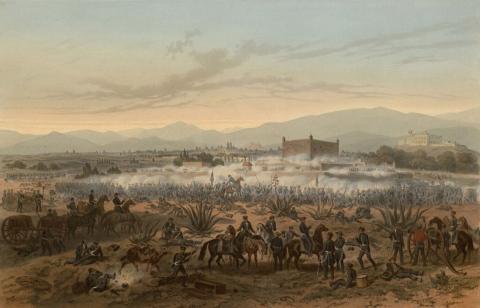Biographies | Broadsides | Correspondence | Diaries & Journals | Newspapers | Images | Maps | Sermons
After the battles at Contreras and Churubusco in August, General Scott halted his attack. The U.S. general had no desire to seize Mexico City by force, having suffered more than one thousand casualties in the recent fighting. Receiving information that the Mexican government was prepared to negotiate, Scott proposed an armistice to discuss peace terms.
The peace held for two weeks, during which time the chief U.S. diplomat, Nicholas Trist, seemed to be making progress with his Mexican counterparts. Pressure from conservatives, however, led Santa Anna to insist on new terms. The Mexican delegates now refused to cede New Mexico, and to give up only a small portion of northern California. Knowing these terms would be unacceptable to his government, Trist broke off negotiations. Scott now prepared to resume hostilities. On September 8, Scott ordered an assault of Molino del Rey (the King's Mill), an iron foundry on the southwestern edge of the capital, rumored to be a factory for manufacturing cannons for the Mexican army. U.S. casualties at El Molino del Rey, approximately 800, were the highest for any single battle during the U.S.-Mexico War. The heavy losses and the fact that no cannons were found at the mill led to recriminations among the U.S. command, and led to a personal rupture between Winfield Scott and William Worth, who had led the attack.
Built during the colonial period, Chapultepec Castle had been abandoned in the years after independence, but had served as a military academy for a decade prior to the outbreak of the U.S.-Mexico War. Situated on a hill two hundred feet high on the western edge of the capital, it overlooked two main causeways that led into the city. Although Santa Anna recognized Chapultepec's strategic importance in the battle for the capital, the Mexican army lacked the time and resources necessary to complete its preparations, or the manpower to adequately defend it.
A U.S. artillery bombardment of Chapultepec began on September 12, and resumed at dawn the following day. At 8 a.m. Scott ordered General Pillow's division to lead an assault on the castle. The attack was temporarily halted while the advance parties waited for storming ladders. Inside the walls, General Nicolás Bravo commanded 1,000 men, some of them cadets from the Colegio Militar. It was an insufficient force to hold back the U.S. onslaught. By 9 a.m. the attackers rushed over the walls and swept into the castle. Half an hour later all opposition on Chapultepec had ended. The young Mexican cadets—some no older than thirteen--would be immortalized as los Niños Heroes, the boy heroes.

